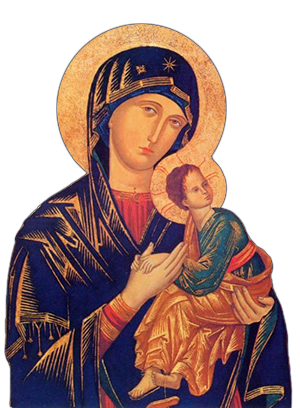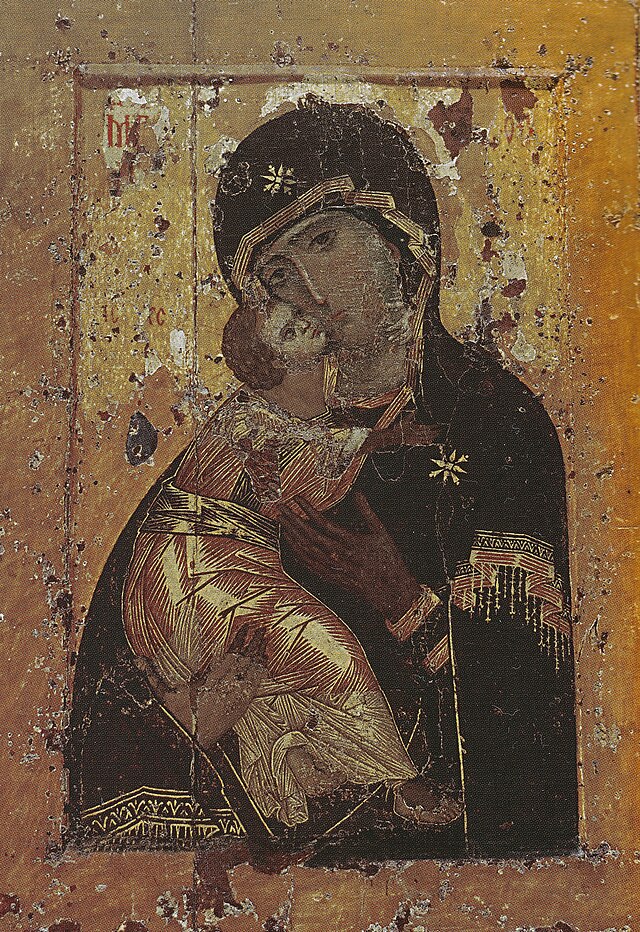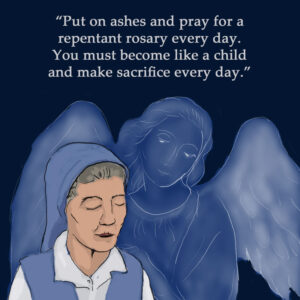Gilbert: Jesus and Mary, Through and Through
What is the appropriate response to the Vatican’s recent doctrinal document? It is very difficult to be level-headed when it comes to defending the honor of one’s own mother.
In my heart, as in the heart of so many others including great saints, I am convinced that Our Lady is the Co-Redemptrix. And it cannot be less true because some find this title difficult, or inappropriate, or bad ecumenical PR. But we need not diminish the difficulty it can pose for a would-be-believer, which is why we haven’t had an Official pronouncement about it from the Church…until now.
And that is the first question the document poses: why now? The zeal we Marians have for Our Lady, to discover and praise every title she has claimed on earth and in heaven, has always been something that comes at a cost. “Priests who venerate me will be scorned by their confreres,” Our Lady told us at Akita. And we make our peace with this, knowing that we have indeed found the narrow gate to the greatest truth in Christianity. But now we are confronted not with a lack of veneration, but the very public pronouncement that what is perhaps the crown of Our Lady’s titles, Co-Redemptrix, is always inappropriate.
We may have a clue to answer the question of why we are hearing this now, after centuries of letting the title be used, the good bishop Athanasius Schneider recalls the following in his interview with Diane Montagna:
St. John Henry Newman, who was recently proclaimed a Doctor of the Church by His Holiness Pope Leo XIV, defended the title Co-Redemptrix before an Anglican prelate who had refused to acknowledge it. He declared: “When they found you with the Fathers calling her Mother of God, Second Eve, and Mother of all Living, the Mother of Life, the Morning Star, the Mystical New Heaven, the Sceptre of Orthodoxy, the All-undefiled Mother of Holiness, and the like, they would have deemed it a poor compensation for such language, that you protested against her being called a Co-redemptress.”[12]
Bishop Athanasius Schneider
One significance of this recollection is that it shows the title has long been a sticking point arguments between Christians, a distinction between Catholics and Anglicans that would stand in the way of unity, an obstacle in the path of Walking Together of the new Synodal Church which seems to be about admitting some amount of protest from each participant.
The second significance of St. John Henry Newman’s argument is more to the point: why are all the other titles bestowed on Our Lady not excessive but Co-Redemptrix is?
The title Co-Redemptrix functions differently than the others in that it states Mary as an integral part of the identity of Jesus. The name Jesus, Yeshua, means God Saves. Salvation is foremost. If Our Lady is integrated to the identity of her son, Christianity too becomes integrated with her in a way that these churches that branched off over the centuries cannot accept. The title is seen as going too far in the direction of Mary to be able to walk together with our Anglican brothers and sisters, with our Lutheran brothers and sisters, etc.
But the fact is, Mary is the perfect Christian. The more we can appreciate this fact, the more we can see our own paths to holiness. Being the Magnifier of God (Luke 1:46), the perfect transmission of Him, she was so filled with His grace that He became the child of her obedience. He became dependent on her, to be nursed and weened and raised into manhood. And that is why she is Co to His Redemption. Because God was incarnate through her. It is God’s choice, not ours, that Salvation should be implemented such that the creature becomes essential to the Creator. The humility of Mary perfects God’s greatness, the infinitesimal polarity of the Infinite. This is not optional but essential in understanding Christianity. And this is why Co-Redemptrix may be the crown of all Marian titles; it expresses with finality a recognition of the essentialness of Mary in being Christian. Whether this essentialness causes ecumenical difficulties is entirely beside the point! We have endured such misunderstandings for centuries and contentious dogmas have been added to, not removed. After all, it’s God’s Church, not ours.
In the story of Our Lady of Good Success, in January of 1610, Mary appeared to Venerable Mother Marianna de Jesus Torres (a woman whose miraculous life is still under consideration for sainthood) and asked her to make a statue in her honor. But Mother Marianna was very concerned with how such a statue would be received by the faithful, seeing that they were quite given to worshipping the wrong thing, and she avoided the request. This disobedience earned her a painful rebuke from the Queen of Heaven:
Mother Marianna protested that she would never be able to describe for an artist such beauty and majesty as the Holy Virgin possessed. Our Lady promised the Conceptionist religious that she herself, with the three Archangels Michael, Gabriel and Raphael, would see the to perfection of this work.
Nonetheless, as the days passed, Mother Marianna felt reluctance to go to the Bishop. First, she feared that he would not believer her and that her demands might endanger the existence of the Covent. Second, she knew that the inhabitants of the Colony still had a strong propensity to idolatry, and she did not want to encourage this tendency.
Thus Mother Marianna de Jesus struggled and prayed from January 21 until the dawn of February 2, 1610.
As was her custom, Mother Marianna was praying in the early morning of February 2 in the upper choir when Our Lady of Good Success appeared to her with a serious and grave demeaner. “Hard-hearted and long-delaying creature, perchance you do not realize that I am an all-powerful Queen, and that I impose orders having full knowledge of all things?” Our Lady said. “Why do you doubt? Why are you afraid when there is nothing to fear? This Convent is my foundation and I love it more than you do….With the making of my Statue I will favor not only my Convent, but also the people and the general public–throughout the centuries.”
Seeing Mother Marianna’s profound humility and contrition for having hesitated, Our Lady, the Mother of Mercy, pardoned her and assured the Conceptionist religious that she herself would intervene to convince the Bishop of the truth of the apparitions.
Our Lady of Good Success: Prophecies For Our Times by Marian Therese Horvat, Ph.D.
Let it be a lesson for us also; to have more concern about honoring Our Lady than whether or the honors themselves will be properly used. Is it not reasonable to think that the Mother of Grace will have sure remedy for those instances where one would make a stumbling block out of her? Is it not better to risk over-honoring than under-honoring God’s Mother since we eventually must stand before Him?
In one of the spare notes offered by the Vatican document to explain their decision against the title of Co-Redemptrix, three popes are cited (see paragraphs 17-21). In short, the rejection of the title rests on a few conversational exchanges from Cardinal Joseph Ratzinger, who undoubtably will be named a Doctor of the Church some day soon, and the continuation of the negative perspective under Pope Francis and, presumably, our new Holy Father, Pope Leo XIV, since he has kept Cardinal Fernandez on as Prefect of the Dicastery for the Doctrine of the Faith. Fernandez provides no theological grounds of his own on which to reject the title. Rather, he quotes an interview in which Cardinal Ratzinger gives commentary on the Letters to the Collosians and to the Ephesians as leaving no room for a Co-Redeemer.
the formula ‘Co-redemptrix’ departs to too great an extent from the language of Scripture and of the Fathers and therefore gives rise to misunderstandings… Everything comes from Him [Christ], as the Letter to the Ephesians and the Letter to the Colossians, in particular, tell us; Mary, too, is everything that she is through Him. The word ‘Co-redemptrix’ would obscure this origin.
God and the World: Believing and Living in Our Time: A Conversation with Peter Seewald
And yet, Mary is at the very origin of Jesus. Mary is part of God’s creation through Jesus and God joins that creation through Mary. There is more through to consider here! Necessity is too poor, too rational a frame for the Story of Salvation. Theologians tell us that a single drop of Jesus’ blood would have sufficed to pay for all of us, but He gave all of it straight from the heart for us (Jn 19:34). He gave us everything he had, including His own mother. And we are left to consider Salvation by the overflowing cup of His Mercy rather than what is strictly necessary in satisfying Divine Justice.
Saint Louis de Montfort describes it thusly:
God the Father made an assemblage of all the waters and He named it the sea, “mare” in Latin. He made an assemblage of all His graces and he named it Mary, “Maria” in Latin. This great God has a most rich treasury in which He has laid up all that He has of beauty, of splendor, of rarity, and of preciousness, even to His own Son; and this immense treasury is none other than Mary, whom the Saints have named the Treasure of the Lord, out of whose plenitude all men are made rich.
Treatise on True Devotion to the Blessed Virgin Mary by Saint Louis de Montfort
It is also important to notice that Ratzinger did not to make any official pronouncement on the title of Co-Redemptrix after he became pope. He may not have liked the title but he loved his predecessor, Saint John Paul II, who employed often. Is it fair to the memory of Pope Benedict XVI and the grand body of Ratzingarian theology to build this official rejection upon a few of his many meetings and interviews? If he had plenty of opportunities as pope to rule against the title and never did so. Can we not commemorate his restraint on the matter by continuing to let it be?
As for the idea that the title is non-Scriptural, the title begins in the Garden of Eden with the Proto Evangelium:
I will put enmities between thee and the woman, and thy seed and her seed: she shall crush thy head, and thou shalt lie in wait for her heel.
Genesis 3:15
Here it is expressed that God’s plan for salvation is intertwined with a woman to come. The phrase, her seed, comes from the Hebrew zera, meaning seed or offspring, with Mary being she from whom God springs. And the head-crushing of Satan comes to pass both literally and metaphorically throughout Scripture through types of Mary (Judges 9:53, Judith 13:10, Esther 7:9). After the Nativity, Our Lady presents Our Lord to Simeon at the Temple. Simeon’s response includes Mary in the same sentence of his prophesy about Jesus:
and Simeon blessed them and said to Mary his mother, “Behold, this child is destined for the fall and rise of many in Israel, and to be a sign that will be contradicted (and you yourself a sword will pierce) so that the thoughts of many hearts may be revealed.”
Luke 2:34-35
Her role in redemption is further revealed at the Wedding of Cana, where Jesus prepares the new wine for the banquet at Our Lady’s intercession. And her identity reaches a culmination in the time between Good Friday and Easter Sunday. Father Linus Clovis offers the following reflection about Holy Saturday:
Our Lady likewise at the foot of the cross stood there, and the possibility of doubt did arise when her son expired, and his dead body was placed in her arms. What grief she must have endured. The grief that she endured was of such intensity that most of the mystics, especially those who have written about the life of Our Lady, said that if God had not kept her alive, she would have died of grief.
But that is not where the battle ended because, on Holy Saturday, no one believed he would rise from the dead. The authorities thought the body might be stolen, but they didn’t believe he would rise from the dead. The Apostles certainly did not believe, and even when he did rise, they doubted, they were skeptical.
And so, Our Lady alone believed, and all of Holy Saturday she was tormented by Satan. He was trying to seduce her into believing that Christ would not rise, that God would not keep his word, that everything that happened was but again to be played. But no, she stood manfully and she won the victory, believing firmly that her son, who is God, would rise and rise from the dead he did, rising on that Easter Sunday. To whom else would he first appear, if not to her? Yet scripture doesn’t tell us he appeared to her, but we can be absolutely certain that he did, and she would be, of course, being the first to rejoice in the resurrection of her son, for she had been faithful up until this moment, and indeed for the rest of her life, for which reason the Church calls her Virgin Most Faithful.
Father Linus Clovis, homily on Our Lady of Akita
This triumph cannot be overstated. We can all see it for what it is regardless of appropriate it is to describe. It is the Triumph of Faith, which belongs alone to the creature. Man needs faith, but he is not assured of faith and God cannot put it in our hearts. Faith is the Fiat of our will to God’s Truth. This is the part of Redemption that does depend on us. As Augustine says, “He who created us without our help will not save us without our consent.” Our Lady is the personification of our consent to Our Lord.
Turn the whole Salvific Story around for a moment…what if we had no Mary to intercede for us? What if she never existed? Is this not the implication made by swatting away the Co from the Redemptrix: that Mary could just as well be anybody and God’s Redemption will happen just the same. A creature is but a creature. The specific person of Mary cannot matter more than any woman because the point made in the document is that role of Redeemer belongs to God alone must stand apart from the creature. But we know from a number of points that Mary is not just any creature. She is someone that God prepared in the Fullness of Time by the Immaculate Conception. In this way she is joined through God’s Providence to the Redeemer. To think of her as any woman causes rupture to the seamless garment of Providence. This is why the ancients could see her in the Divine Plan many centuries before she walked the earth. Who is she, asks the prophet, that cometh forth as the morning rising, fair as the moon, bright as the sun, terrible as an army set in array? (Song of Songs 6:9)
As I sat reflecting on the various problems this latest Vatican document poses, with some turmoil in my heart, not wanting to have a reaction that my mother would not approve of, I turned to an icon I have on my desk, Our Lady of Vladimir, which is my favorite. The icon has suffered damage and was restored a few times over the centuries. Today, only the faces of Jesus and Mary are original. Those faces communicate so much more than mere words can. The perpetual serenity of Mary, somehow at peace despite knowing the prophesy of suffering to come. The life-giving joy of her little Jesus, looking up at her with insatiable fondness. He wraps one arm eagerly around her neck to be as close as possible to her; their special, supernatural and natural togetherness, both now and after the Cross in the image of the Pieta. The moments in their lives captured for us, once true and always true: God Himself and the person who said yes to Him, yes to who He Is rather than who she wanted Him to be, yes to His sacrifice for us sinners, and her life given to acceptance of that sacrifice, to see long hours of brutal punishment happen to her perfect Son because that was God’s Will. Is she not the Co-Redemptrix? We must let beauty speak for itself in this matter. It is a mystery not to be grasped. It can’t be explained, it just is so. The answer to the question of the title be no less than Mary herself. Make her more evident and her titles will be too.





